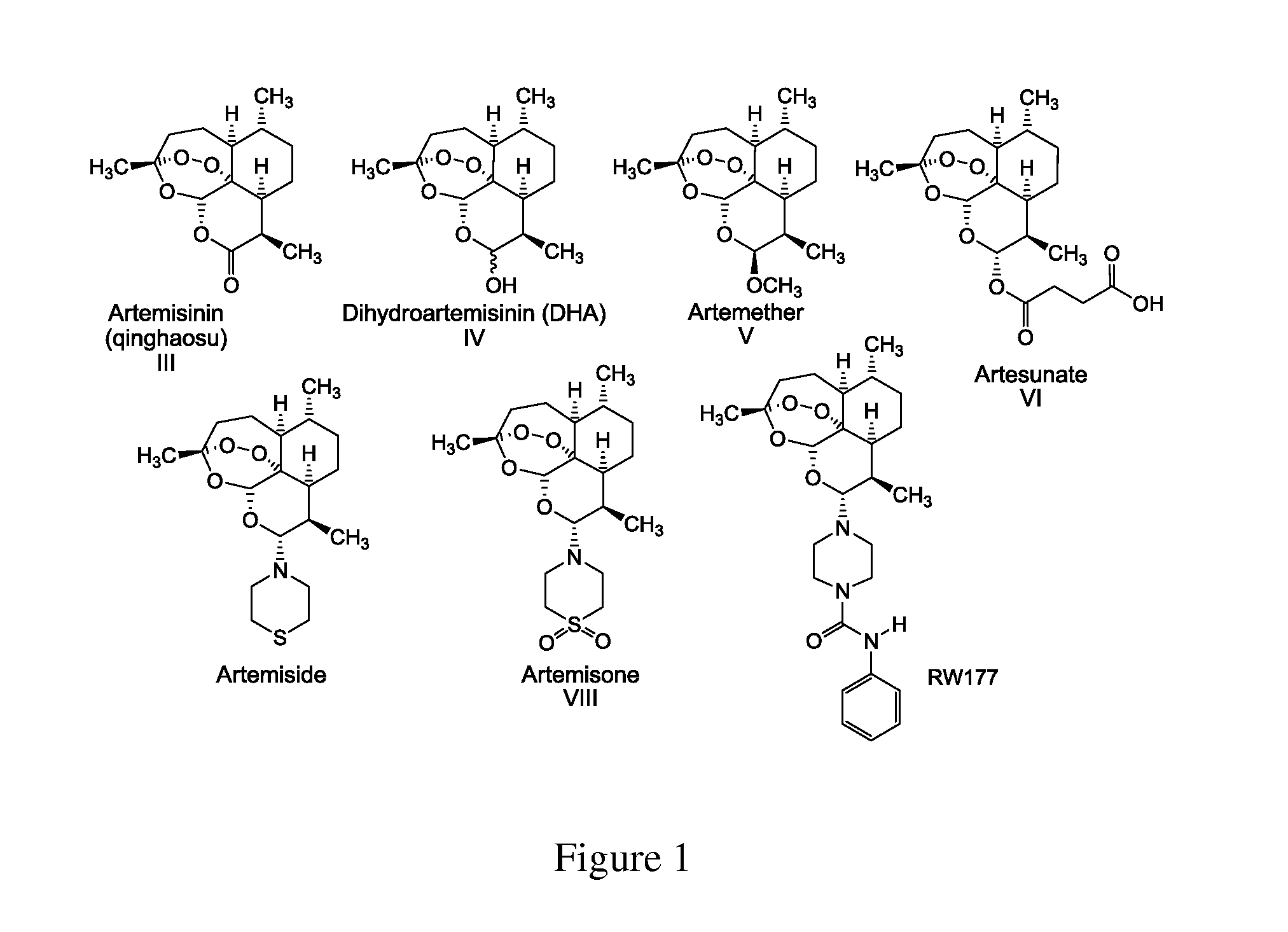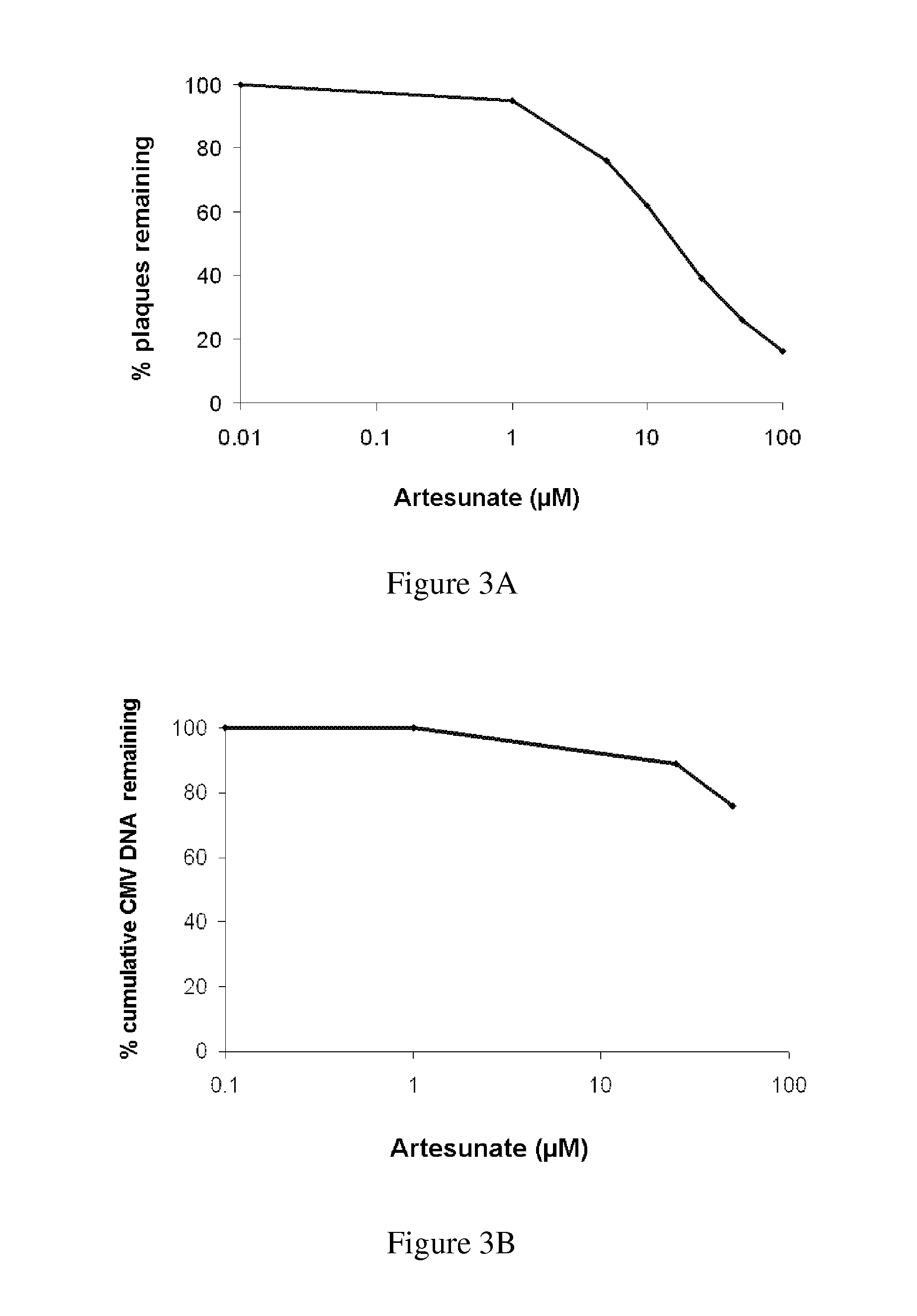Methods and compositions for treating viral infections
a technology for viral infections and compositions, applied in the direction of drug compositions, biocide, heterocyclic compound active ingredients, etc., can solve the problems of immunocompromised individuals' morbidity and mortality, neurological damage and hearing loss, and no established prenatal antiviral treatment is availabl
- Summary
- Abstract
- Description
- Claims
- Application Information
AI Technical Summary
Benefits of technology
Problems solved by technology
Method used
Image
Examples
example 1
Highly Potent Anti-Viral Activity of Artemisone and Compound IX as Determined by Plaque Reduction Assay
Materials and Experimental Methods
Virus, Cells, and Tested Compounds
[0151]The CMV strains used were: AD169 (obtained from the American Type Culture Collection), and TB40 / E. In addition, low-passage clinical isolates CI704, and CI893, recovered at the Hadassah Clinical Virology Laboratory from the urine of congenitally-infected newborns, and propagated for 3-5 passages, were used for some experiments. All CMV strains were propagated and titered in human foreskin fibroblasts (HFF) cells. Cell-free virus stocks and cell-associated clinical isolates were maintained at −70° C. Viral stocks were titered by serial 10-fold dilution in 24-well tissue culture plates containing HFF monolayers overlaid with agarose-medium. After incubation for 7 to 10 days, plaques were enumerated, and virus titer was determined as plaque forming units (PFU) per milliliter (ml). Stocks of artemisone, artemisid...
example 2
Confirmation of Highly Potent Anti-Viral Activity of Artemisone by Viral DNA Quantitation
Materials and Experimental Methods
Quantification of Viral DNA
[0155]Viral DNA quantity in infected cells with and without added drugs (expressed as genome copies / well) was determined by real-time PCR assay, following DNA extraction from cells, with the use of primers and probe derived from the CMV gB gene. The assay is known to demonstrate a linear quantitation over a 6-log range with a sensitivity of 50 copies / ml.
Results
[0156]The results of Example 1 were confirmed by quantitation of viral DNA using real-time PCR. These assays confirmed that artemisone possesses enhanced antiviral efficacy, far superior to that of artesunate. Representative curves of viral DNA accumulation for artemisone and artesunate are depicted in FIGS. 2B and 3B, respectively.
[0157]Thus, antiviral susceptibility and viral DNA quantitation assays revealed that artemisone is a highly effective inhibitor of CMV replication and...
example 3
Artemisone Effectively Inhibits CMV Immediate Early (IE) Gene Expression
Materials and Experimental Methods
Analysis of Viral Gene Expression
[0158]Human foreskin fibroblasts (HFF) were infected with HCMV strain AD169. At 1 hour post infection (hpi), artemisone (25 μM) or ganciclovir (25 μM) were added to the growth medium, and the cells were further incubated in the presence of the drug, until prepared for immunofluorescence analysis at 24 and 72 hpi—to analyze the expression of IE and pp65, respectively. Control untreated infected cells, and mock-infected cells were analyzed in parallel.
[0159]Cells grown on 8-well glass slides were infected at a multiplicity of infection (moi) of 0.1 PFU / cell. Supernatant was removed at 24 and 72 hpi, and cells were washed 3 times with PBS and fixed with 3.7% formaldehyde for 30 minutes at room temperature. Cells were washed 5 times with PBS+1% NH4Cl, permeabilized by 0.1% TX100 for 5 minutes and washed 5 times with PBS+1% NH4...
PUM
| Property | Measurement | Unit |
|---|---|---|
| Structure | aaaaa | aaaaa |
Abstract
Description
Claims
Application Information
 Login to View More
Login to View More - R&D
- Intellectual Property
- Life Sciences
- Materials
- Tech Scout
- Unparalleled Data Quality
- Higher Quality Content
- 60% Fewer Hallucinations
Browse by: Latest US Patents, China's latest patents, Technical Efficacy Thesaurus, Application Domain, Technology Topic, Popular Technical Reports.
© 2025 PatSnap. All rights reserved.Legal|Privacy policy|Modern Slavery Act Transparency Statement|Sitemap|About US| Contact US: help@patsnap.com



